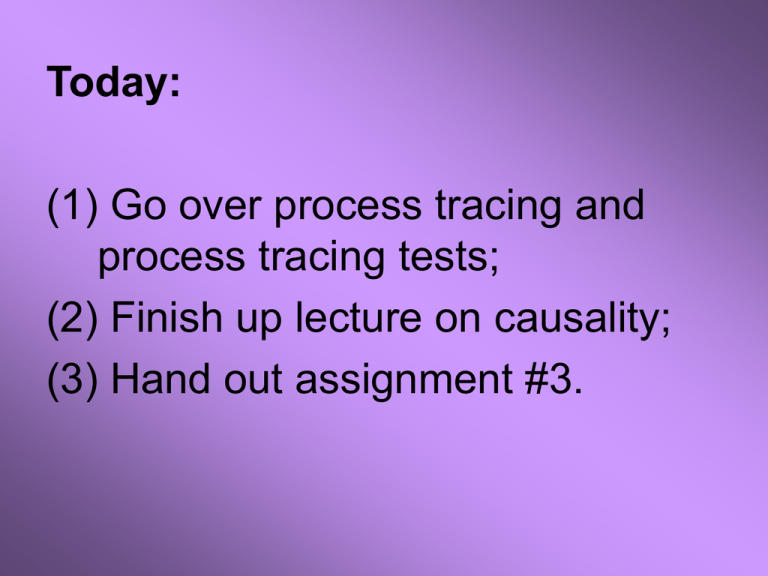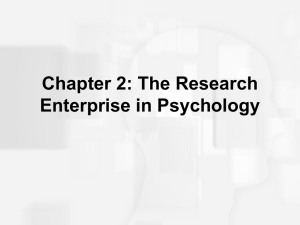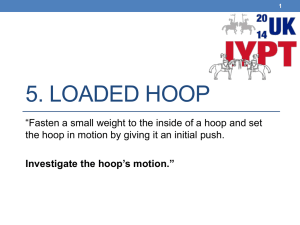
Today:
(1) Go over process tracing and
process tracing tests;
(2) Finish up lecture on causality;
(3) Hand out assignment #3.
Key ideas for assignment #3:
Process tracing: a qualitative
method of looking at data within a
particular case to make
inferences about that case.
Process tracing is a method that
can work with only one case.
It has strong parallels to detective
work and the kind of reasoning
that juries use in trials.
Causal-process observations
(CPOs): specific pieces of
information or data from within a
case that are useful for making
judgments about causation.
You can think of them as similar to
“clues” about a case.
For example, in the Tannenwald
article, specific conversations in
which foreign policy decision
makers had trouble discussing
nuclear use are CPOs.
Data-set observation: the scores
or values for a case across all
systematically measured
variables.
This is often what we mean by a
“case” when we have a
rectangular dataset.
Eye
Color
Height Sex
You
Green
5’ 3’’
Me
Blue
5’ 10
Male
(almost
5’ 11’’
really)
Age
Female 21
42
Place
of
Birth
Miami,
FL
Davenport, IA
Process tracing tests:
(1) Hoop tests;
(2) Smoking gun tests;
(3) Straw in the wind tests;
(4) Doubly decisive tests.
All of these tests involve
relating:
(1) Specific pieces of evidence
(CPOs), to
(2) Preexisting generalizations that
apply more broadly.
Hoop test:
Passing a hoop test is necessary
but not sufficient for the validity of
a given hypothesis.
This kind of test can eliminate a
given hypothesis but it cannot
always provide strong support
that the hypothesis is valid.
Example
Hypothesis: O.J. Simpson
intentionally caused the death of
Ron Goldman.
Hoop test:
Was O.J. in the general area at the
time that Goldman was killed?
Some hoop tests are harder to
pass than others:
(1) Was O.J. on the planet Earth at
the time that Goldman was
killed?
(2) Was O.J. at the Nicole Brown
Simpson home at the time that
Goldman was killed?
Failing a hoop test always
eliminates a hypothesis.
Passing a hoop test lends support
in favor of a hypothesis only to
the degree that it is a hard test.
What makes a hoop test easy or
hard?
The difficulty of a hoop test is
related to the frequency at which
the CPO is typically or normally
present.
Hoop tests that make reference to
rare CPOs are hard hoop tests.
Hoop tests that make reference to
common CPOs are easy hoop
tests.
Other hoop tests:
(1) Is O.J. right handed?
(2) Did O.J. have motive to carry
out a violent murder?
(3) Does O.J.’s hand fit the glove?
Smoking gun test:
With these tests, one has access to
evidence that acts like a smoking
gun in a murder investigation: the
evidence is sufficient but not
necessary for the validity of a
given hypothesis.
Smoking gun tests are used
primarily to confirm the validity of
a hypothesis.
Failing a smoking gun test does not
mean that a hypothesis is
necessarily wrong.
Example from O.J. investigation:
Traces discovered at the crime
scene included Simpson’s DNA in
blood samples from footprints and
the glove.
Goldman’s DNA was found in
Simpson’s Bronco.
Nicole Brown Simpson’s DNA was
found in the Bronco and on a
sock in Simpson’s bedroom.
The defense suggested that one of
the detectives may have
intentionally planted blood in
Simpson’s Bronco by using the
bloody glove found at Simpson’s
estate.
They also suggested that the DNA
samples were degraded and
suffered from crosscontamination.
How consequential was the
absence of the murder weapon
for challenging the validity of the
hypothesis that Simpson was the
murderer?
It might depend on difficult/unusual
it would have been to not find the
weapon.
Straw in the wind test:
Provides some support for or
against a hypothesis, but it is not
decisive.
Example:
Passing a hard hoop test provides
straw in the wind evidence in
favor of a hypothesis.
Back to causality lecture . . .
4 Criteria of Causality:
(1) Time Order
(2) Association
(3) Not Spurious
(4) Mechanism
(2) Association: there is a
“systematic relationship” between
variables or events.
One kind of association:
a correlation
Correlation with dichotomous variables I:
present
Cases here
Dependent
Variable
absent
Cases here
absent
present
Independent Variable
Correlation with dichotomous variables I:
present
Cases here
Good
Grade
absent
Cases here
absent
present
Studies a lot
Correlation with dichotomous variables II:
present
Cases here
Dependent
Variable
Cases here
absent
absent
present
Independent Variable
We can also think about correlations using
continuous data.
High
Dependent
Variable
Low
Low
High
Independent Variable
Example:
xxx
High
xxxx
xxxx
xx
Level of
Democracy
Low
xxxxxx
xxxxx xx
xxxx
x x x xxx
xxxx
Low
x
xx
High
Level of Economic Growth
Please notice the relationship
between the two-by-two table for
dichotomous variable correlations
and the scatterplot for continuous
variable correlations.
(I will help you notice it!)
Another kind of association: a necessary
condition (actually a type of asymmetrical
correlation).
present
Dependent
Variable
absent
absent
present
Independent Variable
For example:
present
Pregnancy
absent
absent
(Male)
Female
present
(Female)
For example:
present
Social
Revolution
absent
absent
present
Authoritarian Government
Question: How would a necessary condition
look with continuous variables?
Dependent
Variable
Independent Variable
Necessary cause: powerful notion
of causality because it implies
that if the cause had not occurred,
then the outcome would not have
occurred.
In that sense, the cause really
seems to have “made a
difference.”
Counterfactual Statement: “If it had
been the case that C (or not C), it
would have been the case that E (or
not E).”
If I had eaten breakfast, I would not be
hungry right now.
Counterfactual because it makes a
claim about the effect of an event in
the past that did not happen (me
eating breakfast).
Always useful to ask about the
counterfactual.
For example: If there was no
nuclear taboo, what would have
happened?
If systematic vulnerability did not
exist, what would have
happened?
Problem of counterfactuals:
We can never directly test them. It
would require “re-running history.”
Instead, we must imagine a
“possible world” in which the
cause did not occur.
Issue: How close is the “possible
world” to the real world? How
much do we have to rewrite
history even to imagine the
possible world?
Example: “If the United States did
not exist, Iraq would be allied with
France.”
Useful counterfactuals require us to
rewrite history only a little bit.
But it is often hard to find such
counterfactuals.
Example: If McCain had won the
election, the economy would be
stronger right now.
The problem of
“over-determination” and
necessary causes:
Soldier 1
Soldier 2
Prisoner Dies
Soldier 3
Soldier 4
The problem of “preemption”
and necessary causes:
Two assassins shoot 5 seconds
apart at a dictator.
Are these actions both causes of
the dictator’s death?
How do we distinguish “trivial” from
important necessary causes?
Rule of thumb: important
necessary causes are rare
events.
“We may define a cause to be an object
followed by objects similar to the
second. Or, in other words, where, if
the first object had not been, the
second never ceased to exist.”
--David Hume
Another kind of association: a
sufficient condition (actually a type
of asymmetrical correlation).
present
Dependent
Variable
absent
absent
present
Independent Variable
Example: Being caught cheating on
the final exam is sufficient for failing
class.
present
Failure in
Class
absent
absent
present
Caught cheating on Final Exam
Question: How would a sufficient condition
look with continuous variables?
Dependent
Variable
Independent Variable
Enough on association!!!
Clearly, it is a big but complicated
part of causation.
Let’s talk about the third criteria:
(3) Non-Spurious Relationship
Sometimes a correlation (whether
symmetrical or asymmetrical) is
spurious. That is, the correlation
exists, but it is not causal.
Spurious correlation: a noncausal correlation.
Note: A spurious correlation is a
correlation. But it is not a causal
association.
We need some examples to make
this point concrete . . .
The number of cracks in the road is
correlated with heart attacks
(areas with lots of cracks in the
road have higher rates of heart
attacks).
Is this a causal relationship? If not,
why not?
How a correlation can become
spurious:
The trick is often to find a new
variable that comes before both
the original independent variable
and dependent variable, and that
causes them both.
Z
X
Y
X
Y
Antecedent variable: A variable
that comes before other variables.
This kind of variable can (but does
not always) make an initial
correlation spurious.
The number of storks living in an
area is correlated with the birth
rate of that area (i.e., areas with
more storks tend to have higher
birth rates).
Countries where people eat lots of
pizza tend to have higher literacy
rates than countries where they
don’t eat so much pizza.
Caffeine consumption is correlated
with miscarriage.
Watching violence on TV is
correlated with carrying out
violent behavior.
Drinking alcohol in moderation is
correlated with fewer heart
attacks.
Smoking is correlated with lung
cancer.
Let us always be mindful also of
time order.
X
Y
Y
X
When you see a correlation, ask
about:
(1) Time order; (2) Association; and
(3) Spuriousness.
Example: Smoking marijuana
and low grades in high school.
(4) Causal Mechanism
If there is a non-spurious association
between variables, then why does the
association exist?
Answer: there must be some
mechanism through which the
independent variable affects the
dependent variable.
X
X
Y
M
Y
How do we find the causal
mechanism?
Possible answer: Process Tracing
Process Tracing: We try to identify
the historical events that link a cause
with its effect.
Example: nuclear taboo => nonuse
nuclear taboo => actual decision
makers’ calculations/strategies =>
non-use
Note: We can always potentially identify
more causal mechanisms.
X
Y
X
X
M
A
M
Y
B
Y
When do we stop looking for
mechanisms?
Possible Answer: When the
relationships are so obvious that
no further process tracing is
needed.








